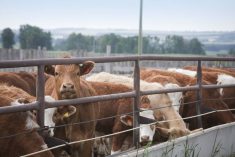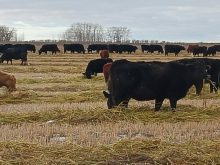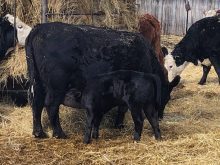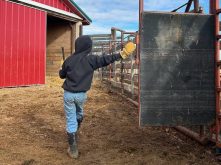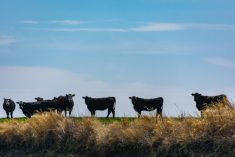After New Year’s, I was driving just south of the Trans-Canada Highway in southern Manitoba and noticed a 100-cow beef herd swath-grazing just along the fence line. Most of these cows were in good body shape, despite it being -25 C and a 25 kph wind (-40 C windchill) on open prairie. I could only assume their hardiness had something to do with the quality of grass laid out in front of them, and that they were fed nutritious supplements elsewhere. If my assumptions proved correct, these cows should overwinter and come into spring calving season without concern.
Read Also

Harvest wraps up and fall work begins
At the Eppich famly ranch in western Saskatchewan, the fall harvest was successful with few breakdowns, cows and calves have been sorted and a new tractor has arrived
Unseen to the naked eye, these overwintering beef cows also be acclimatizing to the frigid temperatures by increasing their metabolic rate to increase heat production at the cellular level. This metabolic priority gives rise to an elevation in their basic energy requirements, which is accompanied by increased heart rate, respiration and blood flow throughout their bodies. This response also triggers feed appetite, which increases feed intake by about 30 per cent, limited by rumen volume, feed digestibility and rate of gastrointestinal. feed passage.
Such safeguards are vital to all stages of gestation in beef cows, but are particularly important for the late-gestation, calving and early-lactating fresh cows. It becomes a matter of assurance that these beef cows are getting enough energy from their feed and producing/conserving energy against the cold to maintain a BCS of 5-6 (thin = 1, and 9 = obese) during the calving season and right afterwards. In the end, all cows with an optimum BCS at calving/post-calving time will have fewer calving problems and better colostrum/milk production for their newborn calf. Later on, they’ll need fewer days to active estrus, and have higher conception rates.
To set up good cold-winter feeding strategies, university and extension research has come up with this rule of thumb: for every 1 C drop in temperature below 0 C, the beef cows’ TDN energy maintenance requirements are increased by about two per cent. Although this is only an estimate and is based upon effective air temperatures, producers can also utilize windchill temperatures without adjustments if the cow herd has little shelter. This means that if our early-morning windchill temperature is -40 C, there is an increase of about 80 per cent in the cows’ basic dietary energy needs.
Sample strategies
I asked a half-dozen beef producers this winter when they planned to feed high-energy grain during such frigid weather. I reminded them that their cow herds would eat only so much good-quality forage in order to maintain body condition, so it was best to increase the energy density of their overwintering diets.
One producer who runs a 150 cow-calf farm had just brought his cows home from an open pasture to a 20-acre paddock where he now rolls out good alfalfa-grass hay bales every morning. He plans to feed to about three to four pounds of barley once they calve out in the middle of February. Another producer who runs a 300-cow purebred/commercial operation feeds a total mixed ration (TMR) of high-energy corn silage and mixed hay. He will add about four to five pounds of a 14 per cent protein/65 per cent TDN grain-screening pellets during the coldest weather. Another producer makes up a TMR with barley silage, grass hay, and three to four pounds of dried distillers’ grains to maintain optimum body condition of her mid-gestation cows (plus replacement heifers) throughout the entire winter.
Most producers also most make use of tree stands and portable windbreak fences that reduce windchill temperatures by 5 to 10 C, or have pole barns that protect cattle when northwest winds pick up. All these producers provide a clean source of water for their cows and make sure there is fresh straw bedding in loafing pens to allow them to lie down on an insulated and comfortable bed.
Their testimonials vary a bit, but their philosophy is very much like my own when it comes to feeding overwintering beef cows. That is, the sole purpose of these cold winter-feeding strategies is to increase their plane of dietary energy in a timely fashion to help the cow herd cope with frigid weather and to maintain vitality and optimum body condition. The payoff of this plan is that a healthy herd of cows will be ready for a successful calving season and beyond.





